check transmission fluid PONTIAC FIREBIRD 1994 Owners Manual
[x] Cancel search | Manufacturer: PONTIAC, Model Year: 1994, Model line: FIREBIRD, Model: PONTIAC FIREBIRD 1994Pages: 290, PDF Size: 14.84 MB
Page 142 of 290

Hill and Mountain
Roads
Driving on steep hills or mountains is
different from driving in flat or rolling
terrain. If you drive regularly in steep
country, or
if you’re planning to visit
there, here are some tips that can make
your trips safer and more enjoyable.
0 Keep your vehicle in good shape. Check all fluid levels and also the
brakes, tires, cooling system and
transmission. These parts can work
hard on mountain roads.
0 Know how to go down hills. The most
important thing to know is this: let
your engine do some of the slowing
down. Shift to a lower gear when you
go down a steep or long hill. Know how
to go uphill. You may
want to shift down to a lower gear.
The lower gears help cool your engine
and transmission, and you can climb
the hill better.
In hilly terrain, you may want to
switch to the
“PERFORMANCE”
mode for better performance.
Stay in your own lane when
driving on two-lane roads in hills or
mountains. Don’t swing wide or cut
across the center of the road. Drive at
speeds that let you stay in
you? own
lane.
As you go over the top of a hill, be
alert. There could be something in
your lane, like a stalled car or’an
accident.
You may see highway signs on
mountains that warn of special
problems. Examples are long grades,
passing or no-passing zones, a’ falling
rocks area, or winding roads. Be alert
to these and take appropriate action.
141 ...
ProCarManuals.com
Page 150 of 290
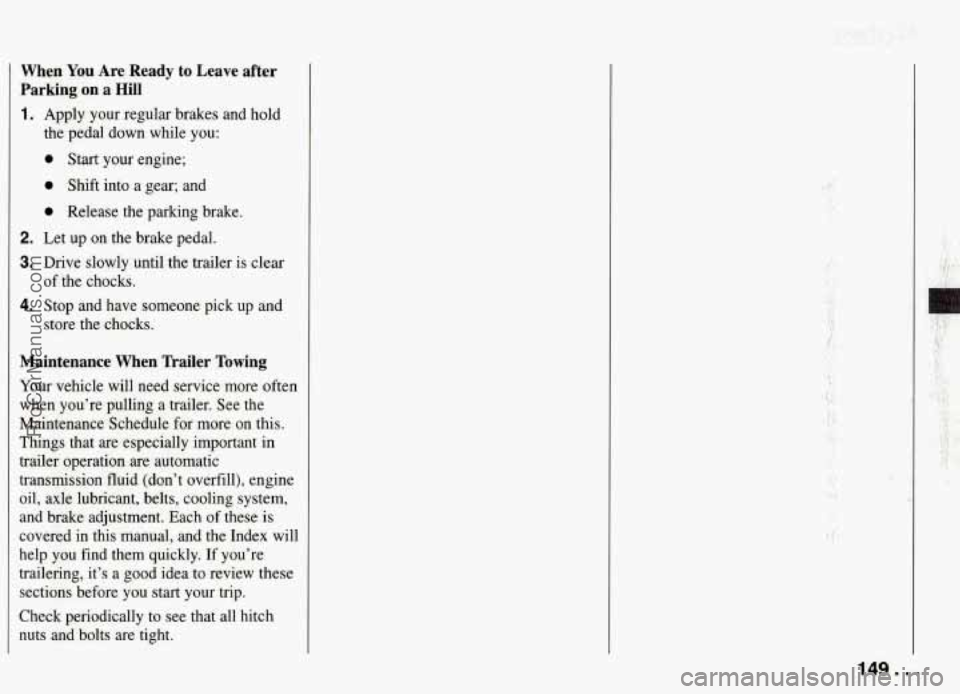
When You Are Ready to Leave after
Parking on a
Hill
1. Apply your regular brakes and hold
the pedal down while you:
0 Start your engine;
0 Shift into a gear; and
0 Release the parking brake.
2. Let up on the brake pedal.
.
3. Drive slowly until the trailer is clear
4. Stop and have someone pick up and
of the chocks.
store the chocks.
Maintenance When Trailer Towing
Your vehicle will need service more often
when you're pulling a trailer. See the
Maintenance Schedule for more on this.
Things that are especially important in
trailer operation are automatic
transmission fluid (don't overfill), engine
oil, axle lubricant, belts, cooling system,
and brake adjustment. Each of these
is
covered in this manual, and the Index will
help you find them quickly. If you're
trailering, it's a good idea to review these
sections before you start your trip.
Check periodically to see that all hitch
nuts and bolts .are tight.
I
I
149.. .
ProCarManuals.com
Page 184 of 290
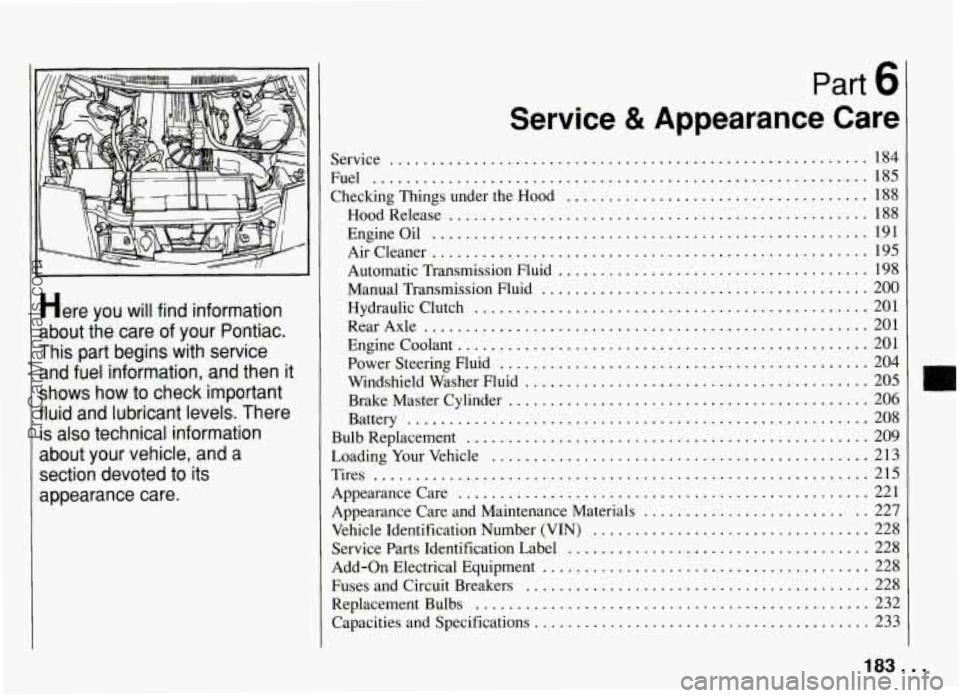
I I
Here you will find information
about the care of your Pontiac
.
This part begins with service and fuel information. and then
it
shows how to check important
fluid and lubricant levels
. There
is also technical information
about your vehicle. and a section devoted
to its
appearance care
.
Part b
Service 8t Appearance Care
Service .........................................................
Fuel ...........................................................
Checking Things under the Hood ....................................
HoodRelease ..................................................
184
185
188
188
Engineoil
.................................................... 191
Aircleaner
.................................................... 195
Automatic Transmission Fluid
..................................... 198
Manual Transmission Fluid
....................................... 200
Hydraulic Clutch
............................................... 201
RearAxle
..................................................... 201
Enginecoolant
................................................. 201
Power Steering fluid
............................................ 204
Windshield Washer Fluid
......................................... 205
Brake Master Cylinder
........................................... 206
Bulb Replacement
................................................ 209
Battery
....................................................... 208
LoadingYourVehicle
............................................. 213
Tires
........................................................... 215
Appearance Care
................................................. 221
Appearance Care and Maintenance Materials
.......................... 227
Vehicle Identification Number (VIN)
................................. 228
Service Parts Identification Label
.................................... 228
Add-on Electrical Equipment
....................................... 228
Fuses and Circuit Breakers
......................................... 228
ReplacementBulbs
............................................... 232
Capacities and Specifications
........................................ 233
183 ...
ProCarManuals.com
Page 199 of 290
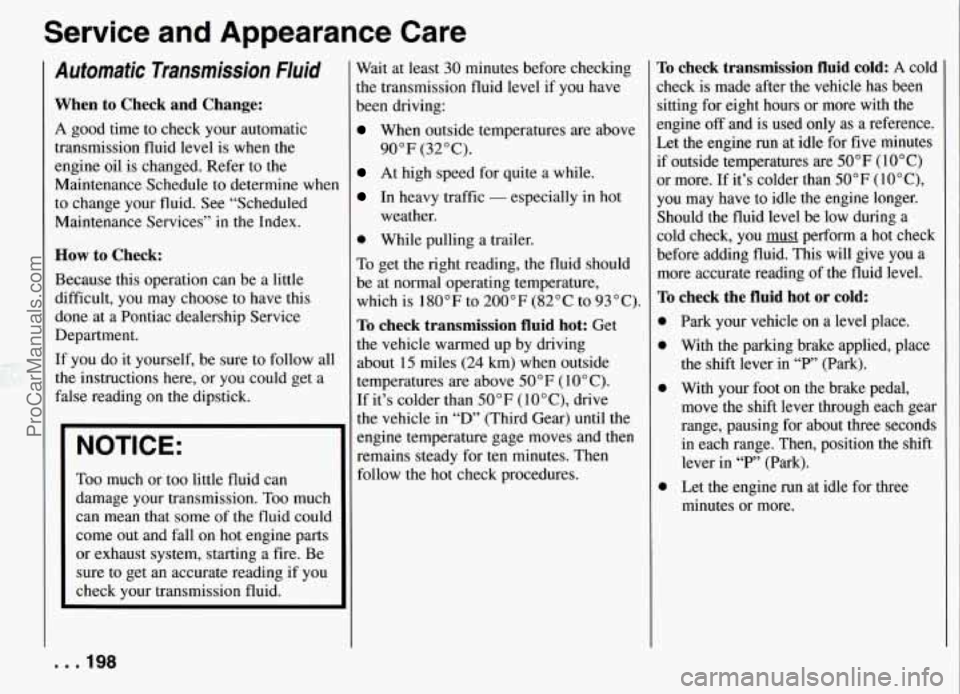
Service and Appearance Care
Automatic Transmission Fluid
When to Check and Change:
A good time to check your automatic
transmission fluid level
is when the
engine oil is changed. Refer to the
Maintenance Schedule to determine when
to change your fluid. See “Scheduled
Maintenance Services” in the Index.
How to Check:
Because this operation can be a little
difficult, you may choose to have this
done at a Pontiac dealership Service
Department.
If you do it yourself, be sure to follow all
the instructions here, or
you could get a
false reading on the dipstick.
Too much or too little fluid can
damage your transmission. Too much
can mean that some of the fluid could
come out and fall on hot engine parts
or exhaust system, starting a fire. Be
sure to get an accurate reading
if you
check your transmission fluid. Wait
at least 30 minutes before checking
the transmission fluid level if you have
been driving:
When outside temperatures are above
At high speed for quite a while.
In heavy traffic - especially in hot
90°F (32°C).
weather.
While pulling a trailer.
To get the right reading, the fluid should
be at normal operating temperature,
which is 180°F to 200°F (82°C to 93°C).
To check transmission fluid hot: Get
the vehicle warmed up by driving
about
15 miles (24 km) when outside
temperatures
are above 50°F ( 10°C).
If it’s colder than 50°F ( lO”C), drive
the vehicle in
“D’ (Third Gear) until the
engine temperature gage moves and then
remains steady for
ten minutes. Then
follow the hot check procedures.
To check transmission fluid cold: A cold
check is made after the vehicle has been
sitting for eight hours or more with the
engine
off and is used only as a reference.
Let the engine run at idle for five minutes
if outside temperatures are 50°F
(10°C)
or more. If it’s colder than 50°F (lO°C),
you may have to idle the engine longer.
Should the fluid level be low during a
cold check, you must perform a hot check
before adding fluid. This will give you a
more accurate reading of the fluid level.
To check the fluid hot or cold:
0
Park your vehicle on a level place.
With the parking brake applied, place
the shift lever
in “P” (Park).
With your foot on the brake pedal,
move the shift lever through each gear
range, pausing for about three seconds
in each range. Then, position the shift
lever in “P” (Park).
Let the engine
run at idle for three
minutes or more.
. . .I98
ProCarManuals.com
Page 200 of 290

3.4L L32 (Code S)
Then, without shutting off the engine,
follow these steps:
1. Pull out the dipstick and wipe it with a
clean rag or paper towel.
1.7L LTI (Code P)
2. Push it back in all the way, wait three
seconds and then pull it back out
again.
3. Check both sides of the dipstick, and
i-ead the lower level. The fluid level
must be in the “COLD” area
for a colc
check
or in the “HOT” area or
cross-hatched area for
a hot check.
4. If the fluid level is in the acceptable
range. push the dipstick back
in all the
way.
How to Add Fluid:
Refer to the Maintenance Schedule to
determine what kind
of transmission fluid
to use. See “Recommended Fluids and
Lubricants”
in the Index.
199 ...
ProCarManuals.com
Page 201 of 290

Service and Appearance Care
If the fluid level is low, add only enough
of the proper fluid to bring the level up to
the “COLD’ area for a cold check or the
“HOT” area for a hot check. It doesn’t
take much fluid, generally less than a pint.
Don’t overfill. We recommend you use
only fluid labeled DEXRON@-I11 or
DEXRON@-IIE, because fluids with
that label are made especially for your
automatic transmission. Dama
e caused
by fluid other than DEXRON
-111 or
DEXRON@-IIE is not covered by your
new vehicle warranty.
0 After adding fluid, recheck the fluid
level as described under
“How to
Check.”
obtained, push the dipstick back in all
the way.
&
When the correct fluid level is
Manual Transmission Fluid
How to Check:
Because this operation can be difficult,
you may choose to have this done at a
Pontiac dealership Service Department.
If you
do it yourself, be sure to follow all
the instructions here, or you could get a
false reading.
NOTICE:
Too much or too little fluid can
damage your transmission.
Too rriuch
can mean that some of the fluid could
come out and fall
on hot engine parts
or exhaust system, starting a
fire. Be
sure to get
an accurate reading if you
check your transmission fluid.
Check the fluid level only when your
engine is off, the vehicle is parked on a
level place and the transmission is cool
enough for you to rest your fingers on the
transmission case.
Then, follow these steps:
1. Remove the filler plug.
2. Check that the lubricant level is up to
the bottom of the filler plug hole.
3. If the fluid level is good, install the
plug and be sure it is fully seated. If
the fluid level is low, add more fluid
as described in the next steps.
How to Add Fluid:
Here’s how to add fluid. Refer to the
Maintenance Schedule to determine what
kind of fluid to use. See “Recommended
Fluids and Lubricants” in the Index.
1. Remove the filler plug.
2. Add fluid at the filler plug hole. Add
only enough fluid to bring the fluid
level up to the bottom of the filler
plug hole.
3. Install the filler plug. Be sure the plug
is fully seated.
. . .200
ProCarManuals.com
Page 236 of 290

tNot all air conditioning refrigerants are the same. If the air con\
ditioning system in your
vehicle needs refrigerant, be sure the proper refrigerant is us\
ed. If you’re not sure, ask
your Pontiac dealer.
“Recheck fluid level after filling. See “Automatic Transmission Fluid” in the Index.
235. . .
ProCarManuals.com
Page 237 of 290
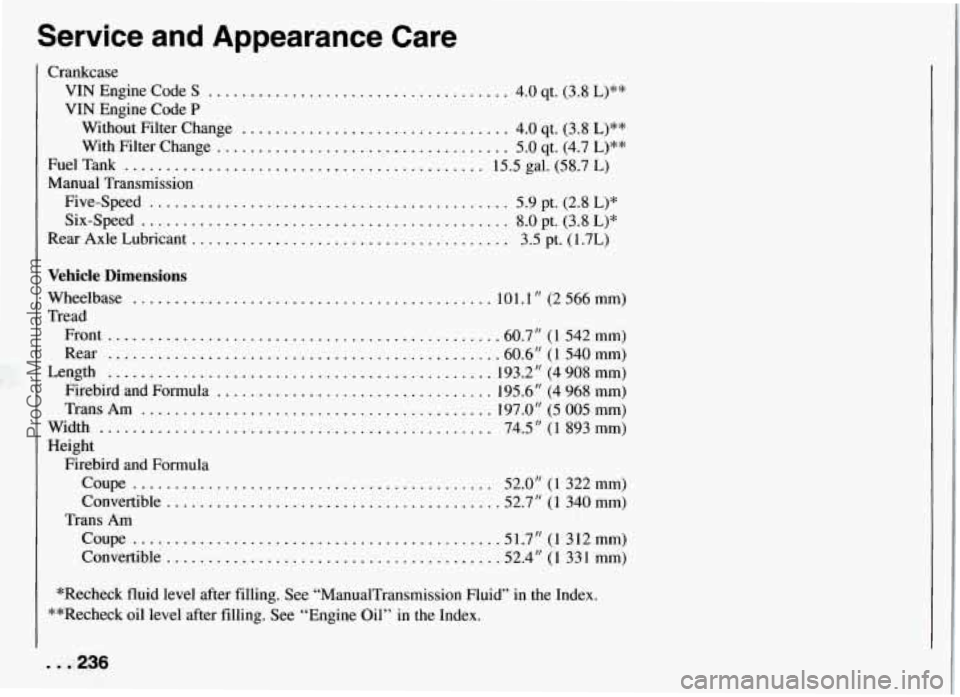
Service and Appearance Care
Crankcase
VIN Engine Code S .................................... 4.0 qt. (3.8 L)**
Without Filter Change
................................ 4.0 qt. (3.8 L)**
With Filter Change ................................... 5.0 qt. (4.7 L)**
Fuel Tank ........................................... 15.5 gal. (58.7 L)
Five-Speed
........................................... 5.9 pt. (2.8 L)*
Six-Speed
............................................ 8.0 pt. (3.8 L)*
Rear Axle Lubricant
...................................... 3.5 pt. (1.7L)
VIN Engine Code
P
Manual
Transmission
Vehicle Dimensions
Tread Wheelbase
........................................... 101.1 I‘ (2 566 mm)
Front
.............................................. .60.7“ ( 1 542 mm)
Rear
.............................................. .60.6” (1 540 mm)
Length
............................................... 193.2“ (4 908 mm)
Firebird and Formula
................................. 195.6” (4 968 mm)
Trans Am .......................................... 197.0” (5 005 mm)
Width
............................................... 74.5” (1 893 mm)
Coupe
........................................... 52.0” (1 322 mm)
Convertible ....................................... .52.7” ( 1 340 mm)
Coupe
........................................... .51.7” (1 312 mm)
Convertible
....................................... .52.4“ (1 331 mm)
Height
Firebird and Formula
Trans Am
*Recheck fluid level after filling. See “ManualTransmission Fluid” in the Index.
**Recheck oil level after filling. See “Engine Oil” in the Index.
. . -236
ProCarManuals.com
Page 247 of 290
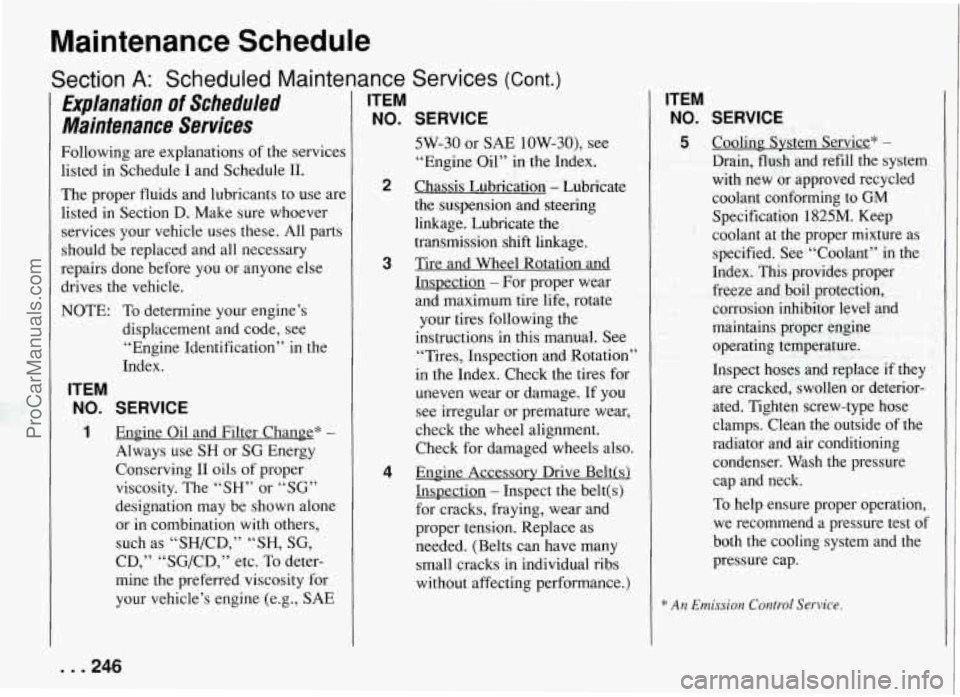
Maintenance Schedule
Section A: Scheduled Maintenance Services (Cont.)
Explanation of Scheduled
Maintenance Services
Following are explanations of the services
listed in Schedule I and Schedule
II.
The proper fluids and lubricants to use are
listed in Section
D. Make sure whoever
services your vehicle uses these. All parts
should be replaced and all necessary
repairs done before you or anyone else
drives the vehicle.
NOTE: To determine your engine’s
displacement and code, see
“Engine Identification” in the
Index.
ITEM
NO. SERVICE
1 Engine Oil and Filter Change* -
Always use SH or SG Energy
Conserving
I1 oils of proper
viscosity. The “SH” or “SG”
designation may be shown alone
or in combination with others,
such as “SH/CD,”
“SH, SG,
CD,” “SG/CD,” etc. To deter-
mine the preferred viscosity for
your vehicle’s engine (e.g., SAE
ITEM
NO.
2
3
4
SERVICE
5W-30 or SAE 10W-30), see
“Engine Oil” in the Index.
Chassis Lubrication
- Lubricate
the suspension and steering
linkage. Lubricate the
transmission
shift linkage.
Tire and Wheel Rotation and
InsDection
- For proper wear
and maximum tire life, rotate
your tires following the
instructions in this manual. See
“Tires, Inspection and Rotation”
in the Index. Check the tires for
uneven wear or damage. If you
see irregular or premature wear,
check the wheel alignment.
Check for damaged wheels also.
Engine Accessorv Drive Belt!s)
InsDection
- Inspect the belt(s)
for cracks, fraying, wear and
proper tension. Replace as
needed. (Belts can have many small cracks in individual ribs
without affecting performance.)
ITEM
NO. SERVICE
5 Cooling: System Service* -
Drain, flush and refill the system
with new or approved recycled
coolant conforming to GM
Specification 1825M. Keep
coolant at the proper mixture as specified. See “Coolant”
in the
Index. This provides proper
freeze and boil protection, corrosion inhibitor level and
maintains proper engine operating temperature.
Inspect hoses and replace if they
are cracked, swollen or deterior-
ated. Tighten screw-type hose
clamps. Clean the outside of the
radiator and air conditioning
condenser. Wash the pressure cap and neck.
To help ensure proper operation,
we recommend a pressure test of
both the cooling system and the
pressure cap.
* An Emission Control Service.
. . .246
ProCarManuals.com
Page 248 of 290

ITEM
NO. SERVICE
6 Transmission Service - For
manual transmissions, fluid
doesn’t require changing. See
“Periodic Maintenance
Inspections.”
For automatic transmissions,
change both the fluid and filter
every 15,000 miles
(25 000 km)
if the vehicle is mainly driven
under one
or more of these
conditions:
In heavy city traffic where the
outside temperature regularly
reaches
90°F (32°C) or
higher.
In hilly or mountainous
terrain.
When doing frequent trailer
towing.
Uses such as found in taxi,
police car or delivery service.
If you do not use your vehicle
under any of these conditions,
change both the fluid and
filter every
100,000 miles
(166 000 km).
ITEM
NO. SERVICE
7
8
9
10
Spark Plug Replacement* -
Replace spark plugs with the
proper type. See “Replacement
Parts” in the Index.
Spark Plug Wire InsPection*t
-
Inspect for burns, cracks or other
damage. Check the boot fit at the
distributor and at the spark plugs.
Replace wires as needed.
Air Cleaner Filter Replacement”
- Replace every 30,000 miles
(50 000 km) or more often under
dusty conditions. Ask your
dealer for the proper replacement
intervals for your driving
conditions.
Fuel Tank. Cap and Lines
Inspection*-/-
- Inspect fuel tank,
cap and lines (including fuel rails
and injection assembly) for
damage or leaks. Inspect fuel cap
gasket for an even filler neck
imprint or any damage. Replace
parts as needed. Periodic
replacement of the fuel filter is
not required.
ITEM
NO. SERVICE
11 Rear Axle Fluid Change - If your
vehicle is used to pull a trailer,
have the rear axle gear lubricant
changed every
7,500 miles
(12 500 km).
If your vehicle is not used to pull
a trailer, but has a limited-sli,p
differential, have the rear axle
gear lubricant changed once, after
the first
7,500 miles (12 500.h).
* An Emission Control Service.
j- The US. Environmental Protection Agency
or the California Air Resources Board has
determined that the failure to pe$orm this
maintenance item will not nullify the emission
warranty
or limit recall liability prior to the
completion
of vehicle useful life. General
Motors, however, urges that all recommended
maintenance services be performed at the
indicated intervals and the maintenance be
recorded in “Section E: Maintenance Record.”
247. . .
ProCarManuals.com